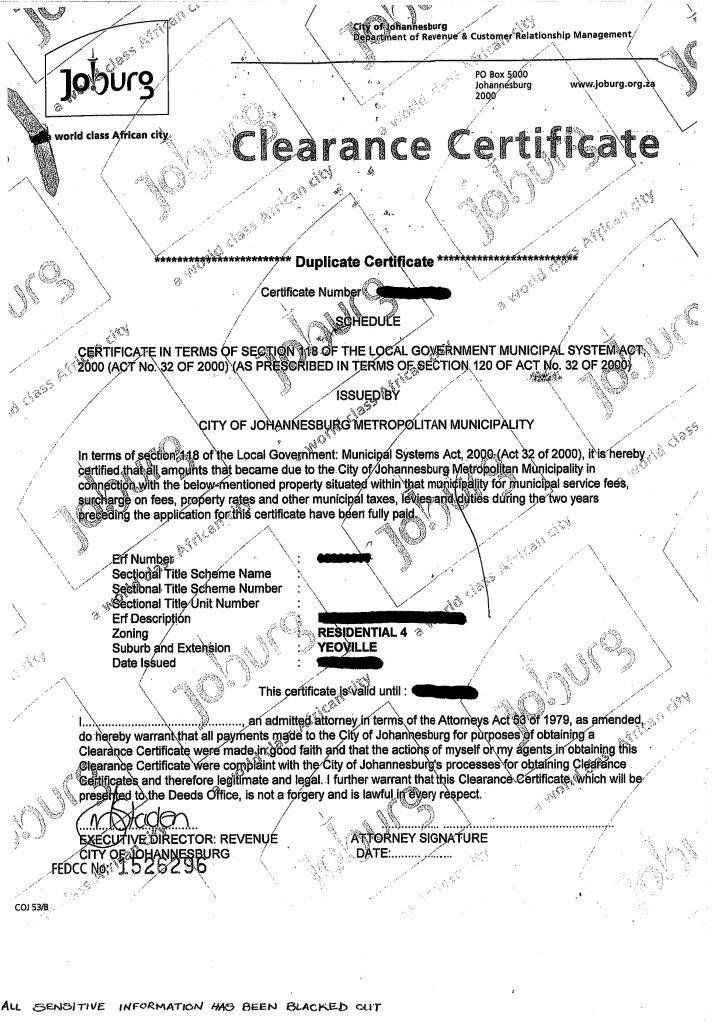What is a rates clearance certificate (R.C.C)? Why do you need one to be able to transfer property

If you own fixed property, you are liable for certain payments to the local authority with jurisdiction over the property. This local authority has the right to collect two types of contributions from property owners:
• A form of tax, which it may utilise to fund its operations, called ‘rates and taxes’.
• Payment for the services rendered to the property owner, such as electricity, water, refuse removal and sewerage services, generally referred to as ‘services’.
AMOUNT OF RATES AND TAXES
The rates and taxes due in respect of a property are based on the value of the property. The municipality examines its budget and its need for income for the particular financial year and then distributes the tax burden amongst the property owners, according to the valuation of the properties. The higher the municipal value of a particular property, the higher the amount of rates and taxes that will be due. Rates and taxes are determined annually, but do not necessary work on a calendar year: generally, they are calculated
to coincide with the municipality’s financial year. Some local authorities require property owners to pay their rates annually in advance (ie at the beginning of the term), while others require a monthly payment.
AMOUNT CHARGED FOR SERVICES
Local authorities bill property owners monthly for services rendered to the property, separate from, and in addition to, the rates and taxes - services such as water, electricity, sewerage removal, refuse removal and the like. Water meters and electricity meters installed on each property measure the water and electricity consumption by the household or business, and the property owners receive monthly accounts for the services used.
WHY IS A RATES CLEARANCE NECESSARY IN A PROPERTY TRANSFER?
The simple answer is that transfer of the property is not possible without it as the Deeds Registries Act prohibits the Registrar from passing transfer without such certificate. This is favorable to a Purchaser who can rest assured that the rates for the 24 months preceding the transfer have been paid in full. The certificate does not cover historic rates (amounts that may be outstanding for a period longer than 24 months) before issue of the clearance certificate.
HOW IS THE RATES CLEARANCE CERTIFICATE OBTAINED?
If a freehold property or sectional title unit is sold, the conveyancers will apply to the relevant local authority for the issue of ‘rates clearance figures’, and after payment of the due amount by the conveyancers, the rates clearance certificate will be issued. On making application, the local authority provides the conveyancing firm with a breakdown of amounts that must be paid before the rates clearance certificate will be issued. The conveyancer collects the money to pay the amounts from the Seller and the local authority will credit the Seller’s account accordingly. (The Seller can discontinue paying monthly rates for the period covered in the assessment.)
PERIOD OF VALIDITY OF A RATES CLEARANCE CERTIFICATE
Rates clearance certificates are valid for 120 days after the date of issue. Thereafter they lapse, and if the transfer is not yet registered by then, new figures will have to be applied for and the process repeated.
ADVANCE RATES
Generally the municipality’s assessment includes a charge for rates and taxes, electricity, water, sewerage and refuse for a period of 90-120 days in advance. This is just a practical measure as the law states that a clearance must remain valid for 60 days from the date of issue. In order to cover the time it takes for the assessment amount to be paid and the 60 day period of validity, it is necessary to include an advance provisions. This amount is not negotiable, but any over payment will be returned to the Seller by the local authority in due course.
WHO PAYS FOR WHAT?
It is generally the Seller’s responsibility to pay all the amounts raised in the assessment. Note that the money must be sent to the conveyancer who will submit it together with any other requirements to the municipality.
REFUNDS AND OVER PAYMENT
After transfer the local authority’s rates department will process any possible refund and return the payment to the Seller. This does not happen automatically. The Seller must submit a refund application to the local authority and then be patient as it often takes the municipality several months to update its records to show that the property has changed hands (despite the deeds office records reflecting this change immediately on the date of transfer), to reconcile the Seller’s accounts, and then to process the refund.
Similarly, the Purchaser may wait a few months before he receives his first rates and taxes bill in respect of the new property, which may come as a shock as payment in respect of a few months may have accrued by this time. In addition, the Purchaser may need to apply to the municipality to open his own electricity account if the account change-over is not automatically dealt with by the municipality.


